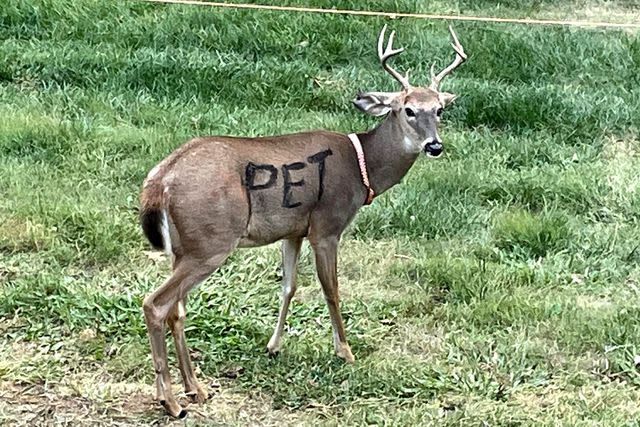Sighting of Deer in Collar with 'Pet' Painted on Its Body Prompts Warning from Mo. Officials
"Somebody most likely took that deer out of the wild as a fawn and tried to keep it as a pet and put a collar on it," the Missouri Dept. of Conservation shared
The Missouri Dept. of Conservation (MDC) responded to an odd report — a deer with a collar around its neck and the word "pet" painted on its body.
The Jefferson County Sheriff's Office shared a photo of the creature on Facebook. It said that officers went down to De Soto, a rural city in Missouri, to investigate the image of the deer, which had gone viral online.
In the photo, the deer looks back at the camera as it grazes on grass. A multi-colored collar can be seen around the animal's neck, and the word "pet" appears in all capital letters on the deer's body.
"Somebody most likely took that deer out of the wild as a fawn and tried to keep it as a pet and put a collar on it," MDC Conservation Captain Scott Corley told McClatchy News, per the Bellville News-Democrat.
Related: Texas Woman Asks For Public's Help Identifying Mysterious Animal Caught on Camera Near Her Home
He told the media outlet that MDC investigated the incident on Sept. 27 after receiving a call from a concerned landowner. The deer — which officials believe is around 2 years old — was gone by the time authorities arrived.
"We're concerned with the health of the deer," Corley said on why MDC does not support trying to domesticate a wild deer. "And nowadays, since we have issues with chronic wasting disease and other disease issues, [interaction] is not safe for humans, and it's not in the best interest of the animal's welfare."

Jefferson County Sheriff's Office
The Jefferson County Sheriff's Office echoed this warning in its Facebook post about the animal: "Wild animals should not be considered pets, and particularly deer should not be moved from their habitat as the (MDC) works on Chronic Wasting Disease."
Chronic wasting disease is a prion disease — a rare progressive neurodegenerative disorder— that affects deer, elk, reindeer, sika deer, and moose, according to the Centers for Disease Control.
The Jefferson County Sheriff's Office added that "orphan wildlife" should be reported to a local MDC office or a conservation agent.
Chronic wasting disease is not the only potential risk of close deer contact. Corley said the photo of the deer also worried officials because docile deer can turn aggressive during mating season.
"When they took him out of the wild his first year … he didn't have all those hormones running through him," he said.
"Now he can be aggressive, and it can cause problems," Corley added, noting that if MDC agents capture the deer, they would remove the collar and try to return the animal to the wild.
Never miss a story — sign up for PEOPLE's free daily newsletter to stay up-to-date on the best of what PEOPLE has to offer, from celebrity news to compelling human interest stories.
Overall, Corley stressed that wild deer should be left alone.
"They have a lot better chance if you leave them where they're at and don't touch them," he said.
For more People news, make sure to sign up for our newsletter!
Read the original article on People.

 Yahoo News
Yahoo News 
